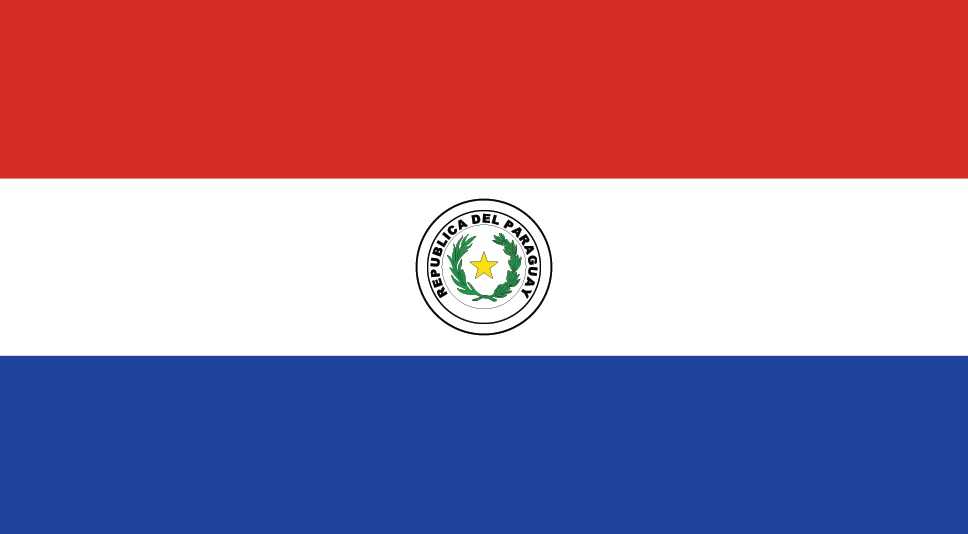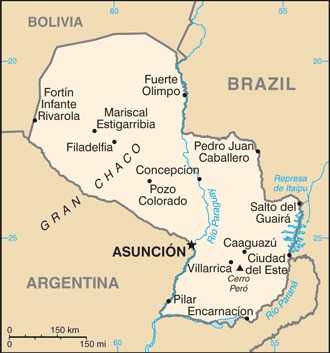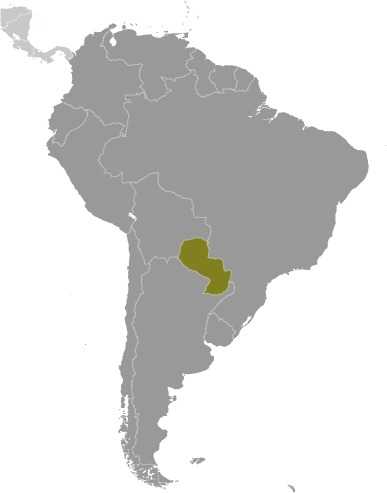Introduction
Background
Several Indigenous groups, principally belonging to the Guarani language family, inhabited the area of modern Paraguay before the arrival of the Spanish in the early 16th century, when the territory was incorporated into the Viceroyalty of Peru. Paraguay achieved its independence from Spain in 1811 with the help of neighboring states. In the aftermath of independence, a series of military dictators ruled the country until 1870. During the disastrous War of the Triple Alliance (1864-70) -- fought against Argentina, Brazil, and Uruguay -- Paraguay lost two thirds of its adult males and much of its territory. The country stagnated economically for the next half-century and experienced a tumultuous series of political regimes. Following the Chaco War of 1932-35 with Bolivia, Paraguay gained a large part of the Chaco lowland region. The 35-year military dictatorship of Alfredo STROESSNER ended in 1989, and Paraguay has held relatively free and regular presidential elections since the country's return to democracy.
Visit the Definitions and Notes page to view a description of each topic.
Geography
Location
Central South America, northeast of Argentina, southwest of Brazil
Geographic coordinates
23 00 S, 58 00 W
Map references
South America
Area - comparative
about three times the size of New York state; slightly smaller than California
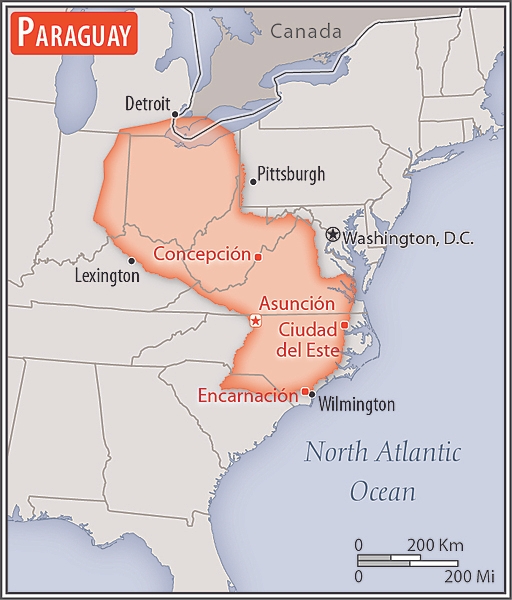
Land boundaries
total: 4,655 km
border countries (3): Argentina 2,531 km; Bolivia 753 km; Brazil 1,371 km
Coastline
0 km (landlocked)
Maritime claims
none (landlocked)
Climate
subtropical to temperate; substantial rainfall in the eastern portions, becoming semiarid in the far west
Terrain
grassy plains and wooded hills east of Rio Paraguay; Gran Chaco region west of Rio Paraguay mostly low, marshy plain near the river, and dry forest and thorny scrub elsewhere
Elevation
highest point: Cerro Pero 842 m
lowest point: junction of Río Paraguay and Río Paraná 46 m
mean elevation: 178 m
Natural resources
hydropower, timber, iron ore, manganese, limestone
Land use
agricultural land: 53.8% (2018 est.)
arable land: 10.8% (2018 est.)
permanent crops: 0.2% (2018 est.)
permanent pasture: 42.8% (2018 est.)
forest: 43.8% (2018 est.)
other: 2.4% (2018 est.)
Irrigated land
1,362 sq km (2012)
Major rivers (by length in km)
Río de la Plata/Paraná (shared with Brazil [s], Argentina, and Uruguay [m]) - 4,880 km; Paraguay river mouth (shared with Brazil [s] and Argentina) - 2,549 km
note – [s] after country name indicates river source; [m] after country name indicates river mouth
Major watersheds (area sq km)
Atlantic Ocean drainage: Paraná (2,582,704 sq km)
Major aquifers
Guarani Aquifer System
Population distribution
most of the population resides in the eastern half of the country; to the west lies the Gran Chaco (a semi-arid lowland plain), which accounts for 60% of the land territory, but only 2% of the overall population
Natural hazards
local flooding in southeast (early September to June); poorly drained plains may become boggy (early October to June)
Geography - note
note 1: landlocked; lies between Argentina, Bolivia, and Brazil; population concentrated in eastern and southern part of country
note 2: pineapples are probably indigenous to the southern Brazil-Paraguay region
People and Society
Population
total: 7,522,549
male: 3,769,376
female: 3,753,173 (2024 est.)
comparison rankings: female 104; male 104; total 104
Nationality
noun: Paraguayan(s)
adjective: Paraguayan
Ethnic groups
Mestizo (mixed Spanish and Indigenous ancestry) 95%, other 5%
Languages
Spanish (official) and Guarani (official) 46.3%, only Guarani 34%, only Spanish 15.2%, other (includes Portuguese, German, other Indigenous languages) 4.1%, no response 0.4%; note - data represent predominant household language (2012 est.)
major-language sample(s):
La Libreta Informativa del Mundo, la fuente indispensable de información básica. (Spanish)
The World Factbook, the indispensable source for basic information.
Religions
Roman Catholic 80.4%, Protestant 7% (Evangelical (non-specific) 6.7%, Evangelical Pentecostal <0.1%, Adventist <0.1%, Protestant (non-specific) <0.1%), Believer (not belonging to the church) 5.7%, other 0.6%, agnostic <0.1%, none 0.2%, unspecified 6.2% (2023 est.)
Demographic profile
Paraguay falls below the Latin American average in several socioeconomic categories, including immunization rates, potable water, sanitation, and secondary school enrollment, and has greater rates of income inequality and child and maternal mortality. Paraguay's poverty rate has declined in recent years but remains high, especially in rural areas, with more than a third of the population below the poverty line. However, the well-being of the poor in many regions has improved in terms of housing quality and access to clean water, telephone service, and electricity. The fertility rate continues to drop, declining sharply from an average 4.3 births per woman in the late 1990s to about 2 in 2013, as a result of the greater educational attainment of women, increased use of contraception, and a desire for smaller families among young women.
Paraguay is a country of emigration; it has not attracted large numbers of immigrants because of political instability, civil wars, years of dictatorship, and the greater appeal of neighboring countries. Paraguay first tried to encourage immigration in 1870 in order to rebound from the heavy death toll it suffered during the War of the Triple Alliance, but it received few European and Middle Eastern immigrants. In the 20th century, limited numbers of immigrants arrived from Lebanon, Japan, South Korea, and China, as well as Mennonites from Canada, Russia, and Mexico. Large flows of Brazilian immigrants have been arriving since the 1960s, mainly to work in agriculture. Paraguayans continue to emigrate to Argentina, Brazil, Uruguay, the United States, Italy, Spain, and France.
Age structure
0-14 years: 22.2% (male 850,191/female 821,237)
15-64 years: 68.4% (male 2,582,021/female 2,561,962)
65 years and over: 9.4% (2024 est.) (male 337,164/female 369,974)
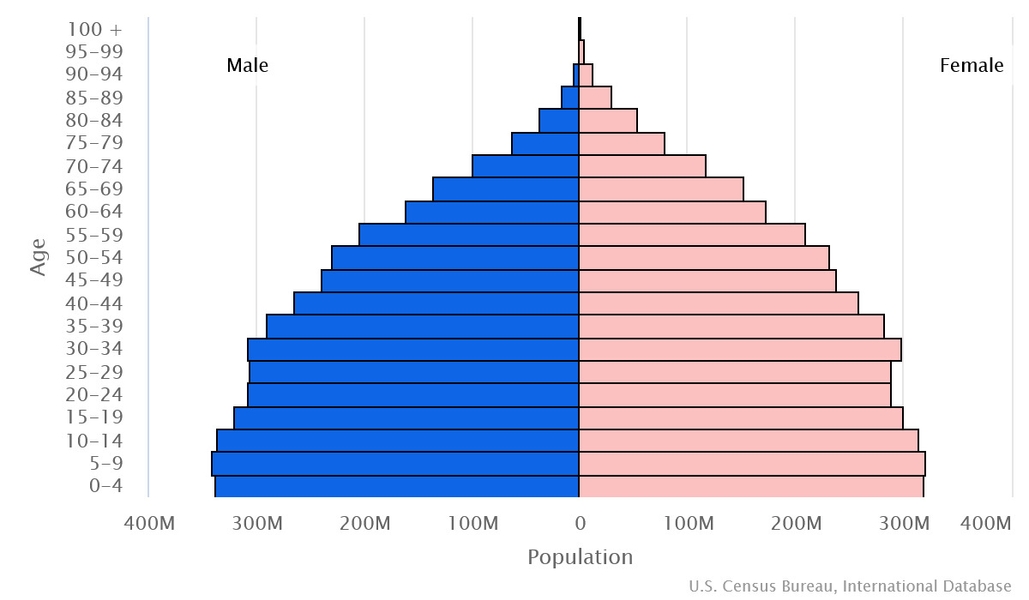
Dependency ratios
total dependency ratio: 54.4
youth dependency ratio: 44.8
elderly dependency ratio: 9.6
potential support ratio: 10.4 (2021 est.)
Median age
total: 31.8 years (2024 est.)
male: 31.6 years
female: 32 years
comparison ranking: total 123
Population distribution
most of the population resides in the eastern half of the country; to the west lies the Gran Chaco (a semi-arid lowland plain), which accounts for 60% of the land territory, but only 2% of the overall population
Urbanization
urban population: 63.1% of total population (2023)
rate of urbanization: 1.64% annual rate of change (2020-25 est.)
Major urban areas - population
3.511 million ASUNCION (capital) (2023)
Sex ratio
at birth: 1.05 male(s)/female
0-14 years: 1.04 male(s)/female
15-64 years: 1.01 male(s)/female
65 years and over: 0.91 male(s)/female
total population: 1 male(s)/female (2024 est.)
Mother's mean age at first birth
22.9 years (2008 est.)
note: data represents median age at first birth among women 25-29
Infant mortality rate
total: 22 deaths/1,000 live births (2024 est.)
male: 26.1 deaths/1,000 live births
female: 17.7 deaths/1,000 live births
comparison ranking: total 70
Life expectancy at birth
total population: 78.8 years (2024 est.)
male: 76.2 years
female: 81.6 years
comparison ranking: total population 73
Gross reproduction rate
0.92 (2024 est.)
Contraceptive prevalence rate
68.4% (2016)
Drinking water source
improved: urban: 100% of population
rural: 100% of population
total: 100% of population
unimproved: urban: 0% of population
rural: 0% of population
total: 0% of population (2020 est.)
Current health expenditure
7.6% of GDP (2020)
Physician density
1.05 physicians/1,000 population (2020)
Hospital bed density
0.8 beds/1,000 population (2016)
Sanitation facility access
improved: urban: 99.6% of population
rural: 90.6% of population
total: 96.2% of population
unimproved: urban: 0.4% of population
rural: 9.4% of population
total: 3.8% of population (2020 est.)
Major infectious diseases
degree of risk: intermediate (2023)
food or waterborne diseases: bacterial diarrhea, hepatitis A, and typhoid fever
vectorborne diseases: dengue fever
Alcohol consumption per capita
total: 5.47 liters of pure alcohol (2019 est.)
beer: 3.27 liters of pure alcohol (2019 est.)
wine: 0.59 liters of pure alcohol (2019 est.)
spirits: 1.59 liters of pure alcohol (2019 est.)
other alcohols: 0.03 liters of pure alcohol (2019 est.)
comparison ranking: total 79
Tobacco use
total: 11.5% (2020 est.)
male: 18.6% (2020 est.)
female: 4.4% (2020 est.)
comparison ranking: total 126
Currently married women (ages 15-49)
59.4% (2023 est.)
Child marriage
women married by age 15: 3.6%
women married by age 18: 21.6% (2016 est.)
Literacy
definition: age 15 and over can read and write
total population: 94.5%
male: 94.9%
female: 94.2% (2020)
Environment
Environment - current issues
deforestation; water pollution; rivers suffer from toxic dumping; tanneries release mercury and chromium into rivers and streams; loss of wetlands; inadequate means for waste disposal pose health risks for many urban residents
Environment - international agreements
party to: Biodiversity, Climate Change, Climate Change-Kyoto Protocol, Climate Change-Paris Agreement, Comprehensive Nuclear Test Ban, Desertification, Endangered Species, Hazardous Wastes, Law of the Sea, Ozone Layer Protection, Wetlands
signed, but not ratified: Nuclear Test Ban, Tropical Timber 2006
Climate
subtropical to temperate; substantial rainfall in the eastern portions, becoming semiarid in the far west
Land use
agricultural land: 53.8% (2018 est.)
arable land: 10.8% (2018 est.)
permanent crops: 0.2% (2018 est.)
permanent pasture: 42.8% (2018 est.)
forest: 43.8% (2018 est.)
other: 2.4% (2018 est.)
Urbanization
urban population: 63.1% of total population (2023)
rate of urbanization: 1.64% annual rate of change (2020-25 est.)
Air pollutants
particulate matter emissions: 12.31 micrograms per cubic meter (2019 est.)
carbon dioxide emissions: 7.41 megatons (2016 est.)
methane emissions: 27.65 megatons (2020 est.)
Waste and recycling
municipal solid waste generated annually: 1,818,501 tons (2015 est.)
Major rivers (by length in km)
Río de la Plata/Paraná (shared with Brazil [s], Argentina, and Uruguay [m]) - 4,880 km; Paraguay river mouth (shared with Brazil [s] and Argentina) - 2,549 km
note – [s] after country name indicates river source; [m] after country name indicates river mouth
Major watersheds (area sq km)
Atlantic Ocean drainage: Paraná (2,582,704 sq km)
Major aquifers
Guarani Aquifer System
Total water withdrawal
municipal: 360 million cubic meters (2020 est.)
industrial: 150 million cubic meters (2020 est.)
agricultural: 1.9 billion cubic meters (2020 est.)
Total renewable water resources
387.77 billion cubic meters (2020 est.)
Government
Country name
conventional long form: Republic of Paraguay
conventional short form: Paraguay
local long form: República del Paraguay
local short form: Paraguay
etymology: the precise meaning of the name Paraguay is unclear, but it seems to derive from the river of the same name; one explanation has the name meaning "water of the Payagua" (an indigenous tribe that lived along the river)
Government type
presidential republic
Capital
name: Asunción
geographic coordinates: 25 16 S, 57 40 W
time difference: UTC-4 (1 hour ahead of Washington, DC, during Standard Time)
daylight saving time: +1hr, begins first Sunday in October; ends last Sunday in March
etymology: the name means "assumption" and derives from the original name given to the city at its founding in 1537, Nuestra Senora Santa Maria de la Asuncion (Our Lady Saint Mary of the Assumption)
Administrative divisions
17 departments (departamentos, singular - departamento) and 1 capital city*; Alto Paraguay, Alto Parana, Amambay, Asuncion*, Boqueron, Caaguazu, Caazapa, Canindeyu, Central, Concepcion, Cordillera, Guaira, Itapua, Misiones, Neembucu, Paraguari, Presidente Hayes, San Pedro
Independence
14-15 May 1811 (from Spain); note - the uprising against Spanish authorities took place during the night of 14-15 May 1811 and both days are celebrated in Paraguay
National holiday
Independence Day, 14-15 May (1811) (observed 15 May); 14 May is celebrated as Flag Day
Constitution
history: several previous; latest approved and promulgated 20 June 1992
amendments: proposed at the initiative of at least one quarter of either chamber of the National Congress, by the president of the republic, or by petition of at least 30,000 voters; passage requires a two-thirds majority vote by both chambers and approval in a referendum; amended 2011
Legal system
civil law system with influences from Argentine, Spanish, Roman, and French civil law models; judicial review of legislative acts in Supreme Court of Justice
International law organization participation
accepts compulsory ICJ jurisdiction; accepts ICCt jurisdiction
Citizenship
citizenship by birth: yes
citizenship by descent only: at least one parent must be a native-born citizen of Paraguay
dual citizenship recognized: yes
residency requirement for naturalization: 3 years
Suffrage
18 years of age; universal and compulsory until the age of 75
Executive branch
chief of state: President Santiago PEÑA Palacios (since 15 August 2023)
head of government: President Santiago PEÑA Palacios (since 15 August 2023)
cabinet: Council of Ministers appointed by the president
elections/appointments: president and vice president directly elected on the same ballot by simple majority popular vote for a single 5-year term; election last held on 30 April 2023 (next to be held in April 2028)
election results:
2023: Santiago PEÑA Palacios elected president; percent of vote - Santiago PEÑA Palacios (ANR) 43.9%, Efraín ALEGRE (PLRA) 28.3%, Paraguayo "Payo" CUBAS Colomés (PCN) 23.6%, other 4.2%
2018: Mario ABDO BENÍTEZ elected president; percent of vote - Mario ABDO BENÍTEZ (ANR) 49%, Efraín ALEGRE (PLRA) 45.1%, other 5.9%
note: the president is both chief of state and head of government
Legislative branch
description: bicameral National Congress or Congreso Nacional consists of:
Chamber of Senators or Camara de Senadores (45 seats; members directly elected in a single nationwide constituency by closed-list proportional representation vote to serve 5-year terms)
Chamber of Deputies or Camara de Diputados (80 seats; members directly elected in 18 multi-seat constituencies - corresponding to the country's 17 departments and capital city - by closed-list proportional representation vote to serve 5-year terms)
elections: Chamber of Senators - last held on 30 April 2023 (next to be held in April 2028)
Chamber of Deputies - last held on 30 April 2023 (next to be held in April 2028)
election results: Chamber of Senators - percent of vote by party/coalition - ANR 45.7%, PLRA 24.4%, PCN 11.5%, PEN 5.2%, PPQ 2.5%, other 10.7%; seats by party/coalition - ANR 23, PLRA 12, PCN 5, PEN 2, PPQ 1, other 2; composition - men 34, women 11, percentage women 24.4%
Chamber of Deputies - percent of vote by party/coalition - ANR 44%, PLRA 30.9%, PCN 8.3%, PPQ 3.6%, PEN 2.9%; other 10.3%; seats by party/coalition - ANR 49, PLRA 21, PCN 4, PEN 2, PPQ 1, other 3; compositio - men 61, women 19, percentage women 23.8%; note - total National Congress percentage women NA%
Judicial branch
highest court(s): Supreme Court of Justice or Corte Suprema de Justicia (consists of 9 justices divided 3 each into the Constitutional Court, Civil and Commercial Chamber, and Criminal Division)
judge selection and term of office: justices proposed by the Council of Magistrates or Consejo de la Magistratura, a 6-member independent body, and appointed by the Chamber of Senators with presidential concurrence; judges can serve until mandatory retirement at age 75
subordinate courts: appellate courts; first instance courts; minor courts, including justices of the peace
Political parties and leaders
Asociacion Nacional Republicana (National Republican Association) - Colorado Party or ANR [Mario ABDO BENITEZ]
Avanza Pais coalition or AP [Adolfo FERREIRO]
Frente Guasu (Broad Front coalition) or FG [Fernando Armindo LUGO Mendez]
GANAR Alliance (Great Renewed National Alliance) (alliance between PLRA and Guasú Front)
Movimiento Hagamos or MH [Antonio "Tony" APURIL]
Movimiento Union Nacional de Ciudadanos Eticos (National Union of Ethical Citizens) or UNACE [Jorge OVIEDO MATTO]
Partido Cruzada Nacional (National Crusade Party) or PCN [Paraguayo "Payo" CUBAS Colomés]; note - formerly Movimiento Cruzada Nacional
Partido del Movimiento al Socialismo or P-MAS [Camilo Ernesto SOARES Machado]
Partido Democratica Progresista (Progressive Democratic Party) or PDP [Rafael FILIZZOLA]
Partido Encuentro Nacional or PEN [Fernando CAMACHO]
Partido Liberal Radical Autentico (Authentic Radical Liberal Party) or PLRA [Efrain ALEGRE]
Partido Pais Solidario or PPS [Carlos Alberto FILIZZOLA Pallares]
Partido Popular Tekojoja or PPT [Sixto PEREIRA Galeano]
Patria Querida (Beloved Fatherland Party) or PPQ [Miguel CARRIZOSA]
International organization participation
CAN (associate), CD, CELAC, FAO, G-11, G-77, IADB, IAEA, IBRD, ICAO, ICC (national committees), ICCt, ICRM, IDA, IFAD, IFC, IFRCS, ILO, IMF, IMO, Interpol, IOC, IOM, IPU, ISO (correspondent), ITSO, ITU, ITUC (NGOs), LAES, LAIA, Mercosur, MIGA, MINURSO, MINUSTAH, MONUSCO, NAM (observer), OAS, OPANAL, OPCW, Pacific Alliance (observer), PCA, PROSUR, UN, UNASUR, UNCTAD, UNESCO, UNFICYP, UNHRC, UNIDO, Union Latina, UNISFA, UNMIL, UNMISS, UNOCI, UNWTO, UPU, WCO, WHO, WIPO, WMO, WTO
Diplomatic representation in the US
chief of mission: Ambassador José Antonio DOS SANTOS BEDOYA (since 15 September 2021)
chancery: 2209 Massachusetts Avenue, NW, Washington DC 20008
telephone: [1] (202) 483-6960
FAX: [1] (202) 234-4508
email address and website:
gabineteembaparusa@mre.gov.py
Embajada de la República del Paraguay ante los Estados Unidos de América :: The Embassy (mre.gov.py)
consulate(s) general: Los Angeles, Miami, New York
Diplomatic representation from the US
chief of mission: Ambassador Marc OSTFIELD (since 9 March 2022)
embassy: 1776 Mariscal Lopez Avenue, Asuncion
mailing address: 3020 Asuncion Place, Washington DC 20521-3020
telephone: [595] (21) 248-3000
FAX: [595] (21) 213-728
email address and website:
ParaguayACS@state.gov
https://py.usembassy.gov/
Flag description
three equal, horizontal bands of red (top), white, and blue with an emblem centered in the white band; unusual flag in that the emblem is different on each side; the obverse (hoist side at the left) bears the national coat of arms (a yellow five-pointed star within a green wreath capped by the words REPUBLICA DEL PARAGUAY, all within two circles); the reverse (hoist side at the right) bears a circular seal of the treasury (a yellow lion below a red Cap of Liberty and the words PAZ Y JUSTICIA (Peace and Justice)); red symbolizes bravery and patriotism, white represents integrity and peace, and blue denotes liberty and generosity
note: the three color bands resemble those on the flag of the Netherlands; one of only three national flags that differ on their obverse and reverse sides - the others are Moldova and Saudi Arabia
National symbol(s)
lion; national colors: red, white, blue
National anthem
name: "Paraguayos, Republica o muerte!" (Paraguayans, The Republic or Death!)
lyrics/music: Francisco Esteban ACUNA de Figueroa/disputed
note: adopted 1934, in use since 1846; officially adopted following its re-arrangement in 1934
National heritage
total World Heritage Sites: 1 (cultural)
selected World Heritage Site locales: Jesuit Missions of La Santísima Trinidad de Paraná and Jesús de Tavarangue
Economy
Economic overview
upper middle-income South American economy; COVID-19 hit while still recovering from 2019 Argentina-driven recession; global hydroelectricity leader; major corruption and money-laundering locale; highly agrarian economy; significant income inequality
Real GDP (purchasing power parity)
$108.022 billion (2023 est.)
$103.159 billion (2022 est.)
$102.978 billion (2021 est.)
note: data in 2021 dollars
comparison ranking: 94
Real GDP growth rate
4.71% (2023 est.)
0.18% (2022 est.)
4.02% (2021 est.)
note: annual GDP % growth based on constant local currency
comparison ranking: 63
Real GDP per capita
$15,700 (2023 est.)
$15,200 (2022 est.)
$15,400 (2021 est.)
note: data in 2021 dollars
comparison ranking: 122
GDP (official exchange rate)
$42.956 billion (2023 est.)
note: data in current dollars at official exchange rate
Inflation rate (consumer prices)
4.63% (2023 est.)
9.77% (2022 est.)
4.79% (2021 est.)
note: annual % change based on consumer prices
comparison ranking: 99
Credit ratings
Fitch rating: BB+ (2018)
Moody's rating: Ba1 (2015)
Standard & Poors rating: BB (2014)
note: The year refers to the year in which the current credit rating was first obtained.
GDP - composition, by sector of origin
agriculture: 17.9% (2017 est.)
industry: 27.7% (2017 est.)
services: 54.5% (2017 est.)
comparison rankings: services 160; industry 97; agriculture 54
GDP - composition, by end use
household consumption: 66.7% (2017 est.)
government consumption: 11.3% (2017 est.)
investment in fixed capital: 17.3% (2017 est.)
investment in inventories: 0.3% (2017 est.)
exports of goods and services: 46.6% (2017 est.)
imports of goods and services: -42.2% (2017 est.)
Agricultural products
sugarcane, maize, soybeans, cassava, rice, wheat, milk, beef, oranges, oil palm fruit (2022)
note: top ten agricultural products based on tonnage
Industries
sugar processing, cement, textiles, beverages, wood products, steel, base metals, electric power
Industrial production growth rate
3.43% (2023 est.)
note: annual % change in industrial value added based on constant local currency
comparison ranking: 98
Labor force
3.469 million (2023 est.)
note: number of people ages 15 or older who are employed or seeking work
comparison ranking: 99
Unemployment rate
5.78% (2023 est.)
6.76% (2022 est.)
7.31% (2021 est.)
note: % of labor force seeking employment
comparison ranking: 117
Youth unemployment rate (ages 15-24)
total: 16.3% (2021 est.)
male: 12.7%
female: 21.9%
comparison ranking: total 106
Population below poverty line
24.7% (2022 est.)
note: % of population with income below national poverty line
Gini Index coefficient - distribution of family income
45.1 (2022 est.)
note: index (0-100) of income distribution; higher values represent greater inequality
comparison ranking: 23
Average household expenditures
on food: 30.3% of household expenditures (2021 est.)
on alcohol and tobacco: 4.2% of household expenditures (2021 est.)
Household income or consumption by percentage share
lowest 10%: 1.8% (2022 est.)
highest 10%: 35.4% (2022 est.)
note: % share of income accruing to lowest and highest 10% of population
Remittances
1.4% of GDP (2023 est.)
1.41% of GDP (2022 est.)
1.47% of GDP (2021 est.)
note: personal transfers and compensation between resident and non-resident individuals/households/entities
Budget
revenues: $7.272 billion (2019 est.)
expenditures: $8.714 billion (2019 est.)
Taxes and other revenues
10.27% (of GDP) (2022 est.)
note: central government tax revenue as a % of GDP
comparison ranking: 184
Current account balance
$109.625 million (2023 est.)
-$2.993 billion (2022 est.)
-$347.383 million (2021 est.)
note: balance of payments - net trade and primary/secondary income in current dollars
comparison ranking: 71
Exports
$18.711 billion (2023 est.)
$14.971 billion (2022 est.)
$14.821 billion (2021 est.)
note: balance of payments - exports of goods and services in current dollars
comparison ranking: 92
Exports - partners
Brazil 36%, Argentina 19%, Chile 12%, Russia 4%, US 3% (2022)
note: top five export partners based on percentage share of exports
Exports - commodities
beef, electricity, soybeans, corn, soybean meal (2022)
note: top five export commodities based on value in dollars
Imports
$17.906 billion (2023 est.)
$17.142 billion (2022 est.)
$14.316 billion (2021 est.)
note: balance of payments - imports of goods and services in current dollars
comparison ranking: 100
Imports - partners
China 28%, Brazil 23%, US 11%, Argentina 8%, Chile 3% (2022)
note: top five import partners based on percentage share of imports
Imports - commodities
refined petroleum, broadcasting equipment, cars, fertilizers, pesticides (2022)
note: top five import commodities based on value in dollars
Reserves of foreign exchange and gold
$9.886 billion (2023 est.)
$9.519 billion (2022 est.)
$9.661 billion (2021 est.)
note: holdings of gold (year-end prices)/foreign exchange/special drawing rights in current dollars
comparison ranking: 84
Exchange rates
guarani (PYG) per US dollar -
Exchange rates:
7,288.872 (2023 est.)
6,982.752 (2022 est.)
6,774.163 (2021 est.)
6,771.097 (2020 est.)
6,240.722 (2019 est.)
Energy
Electricity access
electrification - total population: 100% (2022 est.)
Electricity
installed generating capacity: 8.833 million kW (2022 est.)
consumption: 17.486 billion kWh (2022 est.)
exports: 21.719 billion kWh (2022 est.)
transmission/distribution losses: 4.8 billion kWh (2022 est.)
comparison rankings: transmission/distribution losses 164; exports 12; consumption 79; installed generating capacity 69
Electricity generation sources
hydroelectricity: 99.7% of total installed capacity (2022 est.)
biomass and waste: 0.3% of total installed capacity (2022 est.)
Coal
consumption: 1,000 metric tons (2022 est.)
exports: (2022 est.) less than 1 metric ton
imports: 200 metric tons (2022 est.)
Petroleum
total petroleum production: 2,000 bbl/day (2023 est.)
refined petroleum consumption: 57,000 bbl/day (2022 est.)
Carbon dioxide emissions
8.234 million metric tonnes of CO2 (2022 est.)
from coal and metallurgical coke: 3,000 metric tonnes of CO2 (2022 est.)
from petroleum and other liquids: 8.231 million metric tonnes of CO2 (2022 est.)
comparison ranking: total emissions 117
Communications
Telephones - fixed lines
total subscriptions: 169,000 (2022 est.)
subscriptions per 100 inhabitants: 2 (2022 est.)
comparison ranking: total subscriptions 123
Telephones - mobile cellular
total subscriptions: 8.659 million (2022 est.)
subscriptions per 100 inhabitants: 128 (2022 est.)
comparison ranking: total subscriptions 97
Telecommunication systems
general assessment: limited progress on structural reform and deficient infrastructure of the landlocked country are obstacles to the telecom platform; effective competition in mobile market, serving 96% of population through LTE; deployment of fiber; operator enabled 109 free Internet points across the country and is looking to expand to 430 points in 2022; dependent on neighboring countries for access to submarine cables (2022)
domestic: fixed-line just over 3 per 100 and mobile-cellular is 119 per 100 of the population (2021)
international: country code - 595; Paraguay's landlocked position means they must depend on neighbors for interconnection with submarine cable networks, making it cost more for broadband services; satellite earth station - 1 Intelsat (Atlantic Ocean) (2019)
Broadcast media
6 privately owned TV stations; about 75 commercial and community radio stations; 1 state-owned radio network (2019)
Internet users
total: 5.159 million (2021 est.)
percent of population: 77% (2021 est.)
comparison ranking: total 91
Broadband - fixed subscriptions
total: 562,369 (2020 est.)
subscriptions per 100 inhabitants: 8 (2020 est.)
comparison ranking: total 89
Transportation
National air transport system
number of registered air carriers: 2 (2020)
inventory of registered aircraft operated by air carriers: 8
annual passenger traffic on registered air carriers: 560,631 (2018)
annual freight traffic on registered air carriers: 1.97 million (2018) mt-km
Heliports
27 (2024)
Merchant marine
total: 108 (2023)
by type: container ship 2, general cargo 22, oil tanker 5, other 79
comparison ranking: total 87
Ports
total ports: 1 (2024)
large: 0
medium: 0
small: 0
very small: 1
ports with oil terminals: 0
key ports: Puerto de Asuncion
Military and Security
Military and security forces
Armed Forces of Paraguay (Fuerzas Armadas de Paraguay; aka Armed Forces of the Nation or Fuerzas Armadas de la Nación): Paraguayan Army (Ejército Paraguayo), Paraguayan Navy (Armada Paraguaya; includes marines), Paraguayan Air Force (Fuerza Aérea Paraguaya)
Ministry of Internal Affairs: National Police of Paraguay (Policía Nacional del Paraguay, PNP) (2024)
note: Paraguay also has a National Counterdrug Bureau (Secretaria Nacional Antidrogas or SENAD) that operates under the presidency
Military expenditures
0.8% of GDP (2023 est.)
0.8% of GDP (2022 est.)
1% of GDP (2021 est.)
1% of GDP (2020 est.)
1% of GDP (2019 est.)
comparison ranking: 142
Military and security service personnel strengths
approximately 20,000 active-duty personnel (13,500 Army; 4,000 Navy; 2,500 Air Force) (2023)
Military equipment inventories and acquisitions
the military's inventory is comprised of mostly older equipment from a variety of foreign suppliers, particularly Brazil and the US (2023)
Military service age and obligation
18 years of age for compulsory (men) and voluntary (men and women) military service; conscript service obligation is 12 months for Army, 24 months for Navy; conscripts also serve in the National Police; volunteers for the Air Force must be younger than 22 years of age with a secondary school diploma (2023)
note: as of 2021, women made up about 6% of the active military
Military - note
the Paraguayan military is responsible for external defense but also has some domestic security duties; while the National Police are responsible for maintaining internal security, the military works with the police through a Joint Task Force (Fuerza de Tarea Conjunta or FTC) in combatting the Paraguayan People’s Army (Ejército del Pueblo Paraguayo or EPP) and transnational criminal organizations; the military has an Internal Defense Operations Command (Comando de Defensa Interna or CODI), which includes the Army, Navy, and Air Force, to coordinate internal security support to the police and other security organizations, such as the National Anti-Drug Secretariat or SENAD
the EPP is a domestic criminal/guerrilla group initially dedicated to a Marxist-Leninist revolution in Paraguay that operates in the rural northern part of the country along the border with Brazil; the activities of the EPP and its offshoots—Marsical López’s Army (EML) and the Armed Peasant Association (ACA)—have consisted largely of isolated attacks on remote police and army posts, or against ranchers and peasants accused of aiding Paraguayan security forces
the Paraguayan military is a small force by regional standards, and its limited equipment inventory is largely obsolete, with some of it pre-dating World War II; it has deployed small numbers of troops on UN missions and cooperates with neighboring countries, such as Argentina and Brazil, on security issues, particularly organized crime and narco-trafficking in what is known as the Tri-Border Area; Paraguay has not fought a war against a neighboring country since the Chaco War with Bolivia in the 1930s (2023)
Space
Space agency/agencies
Space Agency of Paraguay (Agencia Especial del Paraguay, AEP; established 2014) (2024)
Space program overview
has a small, recently established space program focused on the acquisition of satellites, satellite data, and the technologies and capabilities to manufacture satellites, as well as promoting in-country expertise building and space industry; a priority is acquiring remote sensing (RS) capabilities to support socio-economic develop, including resource mapping, weather, and crop monitoring; has built a cube satellite with foreign assistance; operates satellites; cooperates with foreign space agencies and industries, including those of India, Japan, Taiwan, the US, and member states of the Latin American and Caribbean Space Agency (ALCE) (2024)
note: further details about the key activities, programs, and milestones of the country’s space program, as well as government spending estimates on the space sector, appear in the Space Programs reference guide
Terrorism
Terrorist group(s)
Terrorist group(s): Hizballah (2022)
note: details about the history, aims, leadership, organization, areas of operation, tactics, targets, weapons, size, and sources of support of the group(s) appear(s) in the Terrorism reference guide
Transnational Issues
Refugees and internally displaced persons
refugees (country of origin): 5,231 (Venezuela) (2022)
Illicit drugs
marijuana cultivation and the trafficking of Andean cocaine in the tri-border area shared with Argentina, and Brazil facilitates money laundering

